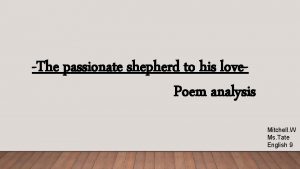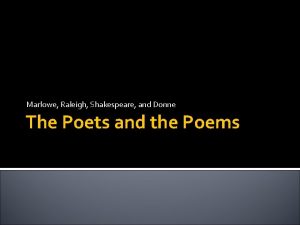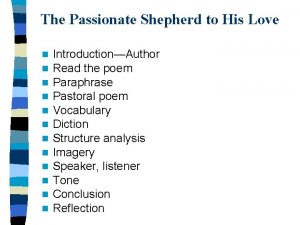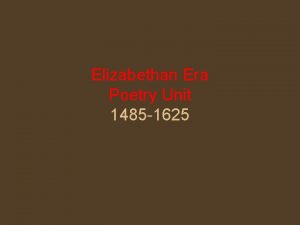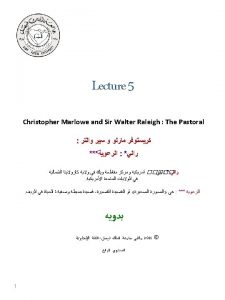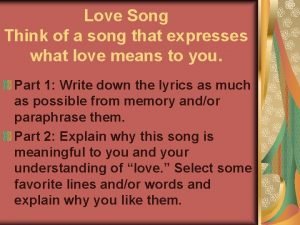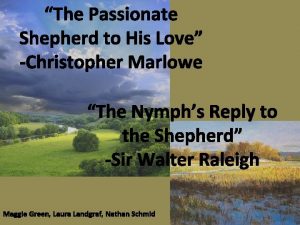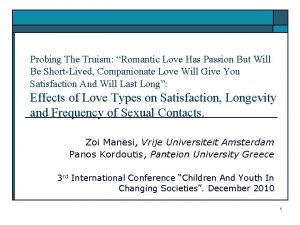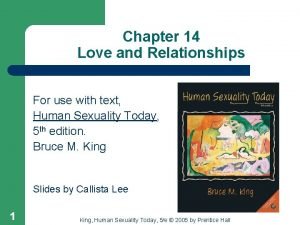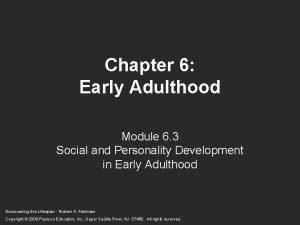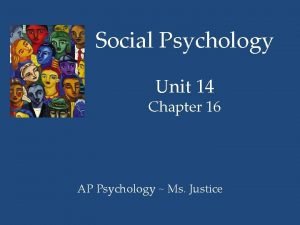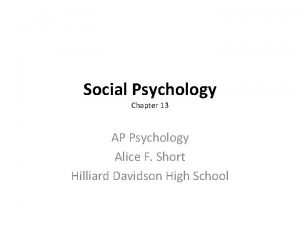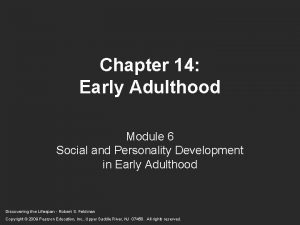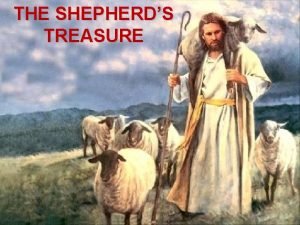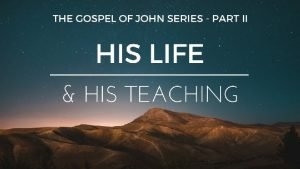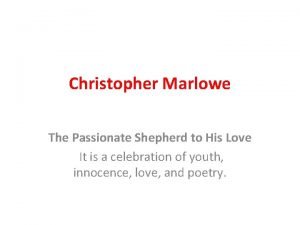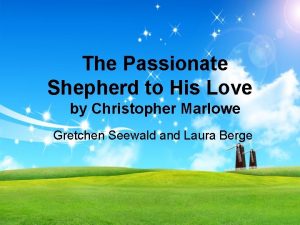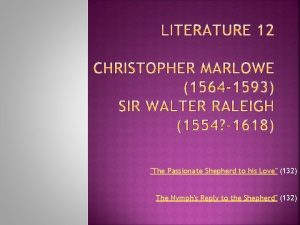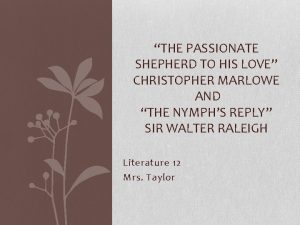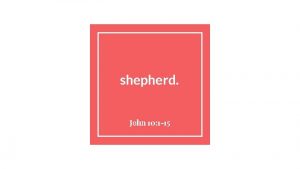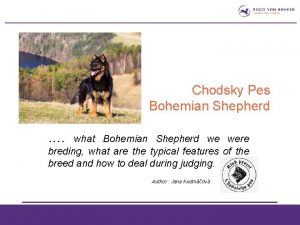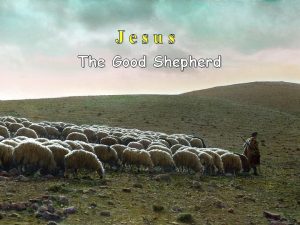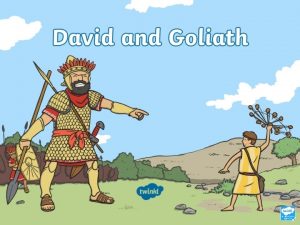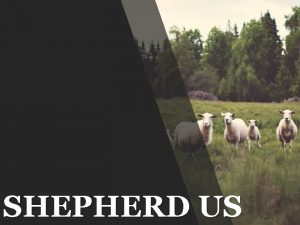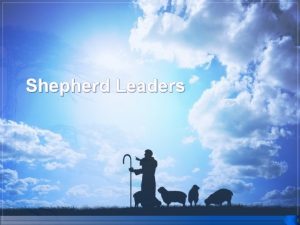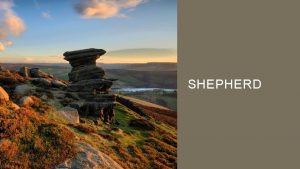The Passionate Shepherd to His Love n n























- Slides: 23

The Passionate Shepherd to His Love n n n Introduction—Author Read the poem Paraphrase Pastoral poem Vocabulary Diction Structure analysis Imagery Speaker, listener Tone Conclusion Reflection

The Passionate Shepherd to His Love Christopher Marlowe

The Author n Christopher Marlowe 1. 1564– 1593 (about 29 years old) He was an English dramatist and poet. Probably the greatest English dramatist before Shakespeare. Education: Marlowe was educated at Cambridge and he went to London in 1587, where he became an actor and dramatist for the Lord Admiral's Company. Plays: His most important plays are the two parts of Tamburlaine the Great (c. 1587), Dr. Faustus (c. 1588), The Jew of Malta (c. 1589), and Edward II (c. 1592). Marlowe's dramas: his dreams have heroic themes, usually centering on a great personality who is destroyed by his own passion and ambition. The use of the language: The poetic beauty and dignity of his language raise them to the level of high art. Marlowe death: In 1593, Marlowe was stabbed in a barroom brawl by a drinking companion. 2. 3. 4. 5. 6. 7.

Paraphrase Come live with me and be my love. We will try all the pleasure offered by valleys, roves, woods and mountains. I want us to sit upon the rocks with shallow rivers falling under our feet, seeing those shepherds far away feeding their sheep, and hearing birds sing beautifully around us. And I will use roses to make beds decorated with a thousand sweet-smelling posies for you to lie. I will weave a flower cap, and make you kirtle fringed with myrtle leaves.

We pull out of the finest wool from our lambs to make a pretty gown. And a pair of highqualited slippers will be made for you, to keep you from being cold. On the slippers I will put buckles, which was made of purest gold. Also, I will make you a belt of straw and ivy buds with coral clasps and amber studs. If these pleasure may touch your heart, come live with me and be my love. The young shepherd shall dance and sing in each May morning to delight you, and if you may be touched by these delights, then live with me and be my love.

Pastoral Poem n Definition a poetic kind that concerns itself with simple life of country folk and describes that life in stylized, idealized terms. n Characteristics 1)The people in the pastoral poem are usually shepherds, although they maybe be fishermen or other rustics who lead an outdoor life and are involved in tending to basic human needs in a simplified society.

2) The world of the poem is one of simplicity, music, and love. The world is always spring, usually May. Nature seems endlessly green and the future entirely golden. Difficulty, frustration, disappointment, and obligation do not belong in this world at all; it is blissfully free of problems. 3) Shepherds sing instead of tending sheep, and they make love and play music instead of having to watch out for wolves in the night. 4) Besides, the language of pastoral is informal and fairly simple, although always a bit more sophisticated than that of real shepherds with real problems and real sheep.

Vocabulary—pastoral description n n n Grove (n. )-a small group of trees. Ex: a grove of birch trees Madrigal / mædrgl/ (n. ) a song for several singers, usually without musical instruments, popular in the 16 th century Posy (n. )- a small bunch of flowers Kirtle (n. )-to decorate fabric with a pattern of stitches usually using colored thread: Ex: an embroidered blouse Shepherd (n. ) - a person whose job is to take care of sheep. Myrtle / m 3 tl; Am. E m 3 rtl/ noun [U, C] a bush with shiny leaves, pink or white flowers and bluish-black berries

n Lined (n. ) -(of clothes) having a lining (a layer of material used to cover the inside surface of sth. : a pair of leather gloves with fur linings ) inside them. Ex: a lined skirt n Buckle-(n. ) a piece of metal or plastic used for joining the ends of a belt or fastening a strap on a bag, shoe, etc n Bud (PLANT PART) noun [C]-a small part of a plant, that develops into a flower or leaf n Coral (n. ) [U]- a rock-like substance, formed in the sea by groups of particular types of small animal, that is often used in jewelry n Clasp (v. ) [T] - to hold someone or something firmly in your hands or arms .

Amber (n. )- a hard transparent yellowishbrown substance which was formed in ancient times from the liquid of trees and is used in jewellery n Stud (JEWELLERY ) (n. )- [C] a small piece of metal jewellery that is put through a part of your body such as your ear or nose n Swain (n. )- youths n

Diction Roses, flowers, leaves, lambs, straw, ivy, coral (stanza 3~5) 1. ) The poet uses these words to describe the pleasant environment and the happiness of the shepherd. 2. ) These words which the poet chooses here all related to natural things and this is also the style of pastoral poems. ※ Besides, there are two words Prove(line 2) and Kirtle(line 11) that the poet chooses instead of Try and Gown in order to rhyme with Love(line 1) and Myrtle(line 12).

Structure n Main Idea: The shepherd makes a lot of things to send his love and in order to show his passionate affection. The poem is divided into three parts: Ⅰ. stanza 1~stanza 2 The speaker hopes his love to live with him and enjoy the beauty of the nature. Ⅱ. stanza 3~stanza 5 The speaker makes many things to please and persuade his love. Ⅲ. stanza 6 The speaker says that everybody welcome his love if she comes to live with him.

n n Rhyme: The poem has a special term of rhyme. Every two lines the rhyme is the same. Repetition: “Come live with me and be my love” (shown on stanza 1, 5, and 6, line 1) The repetition of the sentences strengthens his passion to his love. In reader’s part, we can understand speaker’s intention much more clearly

Imagery--Functions n visual image: 1. sit upon the rocks. . . 2. seeing the shepherds feed their flocks by shallow rivers 3. The shepherd swains shall dance and sing. audio image: melodious birds sing madrigals n Smell image: a thousand fragrant posies n

The Speaker & Listener n The speaker: the passionate shepherd The shepherd’s personality: 1)sincere: He makes many things such as beds of roses, fragrant posies, flower cap, kirtle, gown, slippers(shown at stanza 2 and 3) to show his sincerity for his love to the lady. 2)rich: He is not an ordinary shepherd, instead, a rich shepherd. We can find evidence at the bottom of stanza 4: “Fair lined slippers for the cold, with buckles of the purest gold. ”

Tone n Sincere In stanza 3~5, the shepherd gives the one he adores lots of things which are made by the shepherd, himself such as beds of roses, fragrant posies, a cap of flowers and a gown, slippers and a belt, and so on in order to show his sincerity to his love. n Passionate The shepherd repeats the sentence “Come live with me and be my love” three times (stanza 1, 5, 6) with a view to expressing his passion and affections to his love.

The speaker&listener(continued) n The Listener: whom the shepherd loves. The lady’s personality: Nature-loving & tired of city life: The shepherd offered natural scenery such as valleys, groves, hills, fields, woods, steep mountains (stanza 1, ) rocks, and rivers (stanza 2) to persuade the lady to come live with him. Our group thinks that if the lady accept the shepherd, she may be nature loving or tired of noisy city life. So that she can get away with those troublesome stuffs and really relax and enjoy her peaceful life with the shepherd.

Comparison between M & R n n n 1. Introduction—Come live with me 2. We will see flocks, hear birds sing 3. Beds of roses, cap of flowers etc. 4. Gown, slippers 5. Belt, coral clasps, buckle 6. Conclusion-- Come live with me… n n n 1. NO, only if, …. 2. Winter drives the flocks away, birds dumb 3. Flowers fade 4. Gown, shoes, belt, cap, kirtle, posies wither 5. They can not move me 6. If love/joy lasts forever, yes, but…

Conclusion n Through this poem, we can understand more about the pastoral poem. The characteristics of pastoral poem are unrealistic and fanciful, and the main characters mentioned in this kind of poem are usually shepherds, sometimes fishermen. Also, the content of pastoral poem are mostly related to nature and we can find the evidences of this kind of style (such as valleys, groves, hills, fields, wood, and steepy mountain yields in the 1 st stanza; rocks, flocks, rivers and birds in the 2 nd stanza).

However, most parts in the poem are related to the descriptions of the nature, but somehow we readers can enjoy the poem by understanding the deep affection the shepherd wants to show. Compared with the poem. “To His Coy Mistress, ” people in 17 th century are much opener and they show their affection more directly. From this poem, “The Passionate Shepherd to His Love, ” we can understand the attitude of people in 16 th century express their love with a gentle and sincere tone.

Thanks for your attention! Thanks for Alice to provide the pictures of myrtle and clasps.

The Myrtle Various plants of the family Myrtaceae; : a European shrub having ovate or lanceolate evergreen leaves and solitary axillary white or rosy flowers followed by black berries

Clasps = Tendrils n A portion or the whole of a leaf, stipule, or stem that is modified into a slender spirally coiling sensitive organ serving to attach a plant (as a peavine or grapevine) to its support and to assist it in climbing
 The passionate shepherd to his love meaning
The passionate shepherd to his love meaning The passionate shepherd to his love summary
The passionate shepherd to his love summary Come be with me and be my love
Come be with me and be my love The passionate shepherd to his love literary devices
The passionate shepherd to his love literary devices The passionate shepherd to his love analysis
The passionate shepherd to his love analysis The passionate shepherd to his love paraphrase
The passionate shepherd to his love paraphrase The passionate shepherd to his love analysis
The passionate shepherd to his love analysis Passionate love vs companionate love
Passionate love vs companionate love Passionate love vs companionate love
Passionate love vs companionate love Types of love
Types of love Richer than gold is the love of my lord
Richer than gold is the love of my lord Labeling theory of passionate love
Labeling theory of passionate love Superordinate goals
Superordinate goals Heightened verse
Heightened verse Passionate love definition ap psychology
Passionate love definition ap psychology Sternbergs theory of love
Sternbergs theory of love Labeling theory of passionate love
Labeling theory of passionate love Love love jesus is love god greatest gift lyrics
Love love jesus is love god greatest gift lyrics Shepherd treasure
Shepherd treasure The shepherd and his flock poem summary
The shepherd and his flock poem summary 12 values
12 values Passion en latin
Passion en latin Build your own life wendy lawson
Build your own life wendy lawson Love begets love do you agree
Love begets love do you agree
